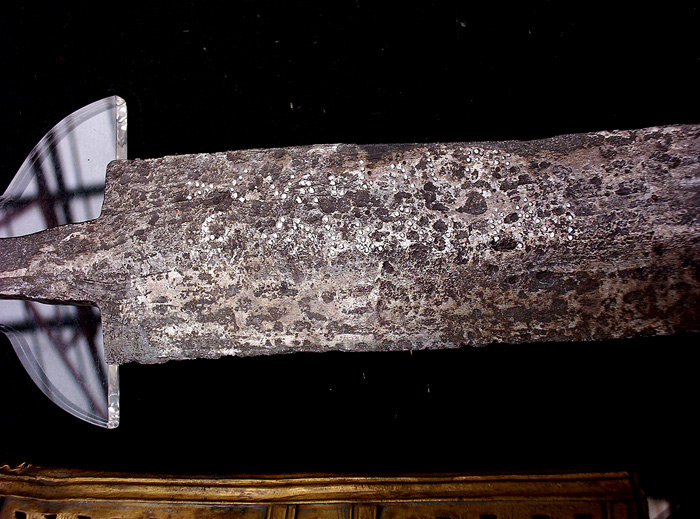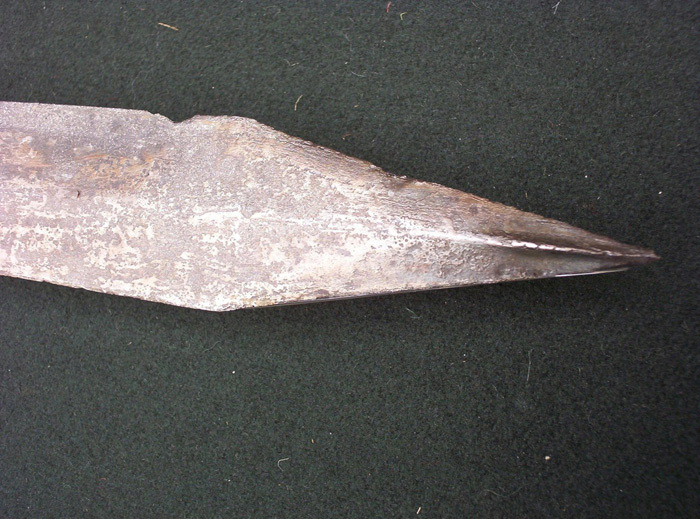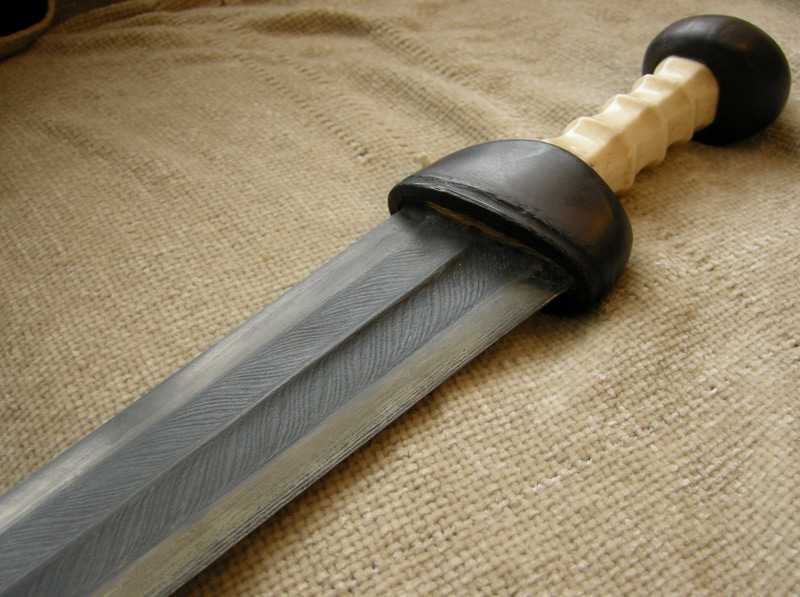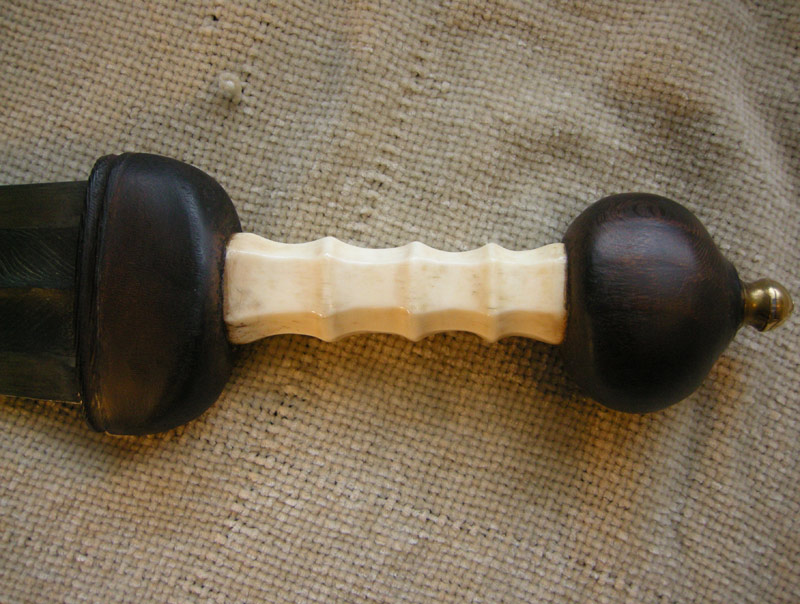This new sword is bothering me. I like it, but cannot love it. Its too perfect, looks like it belongs in surgery. Re-watched Gladiator's first battle scene. I read Sean's antiquiing feature few times, & searched myArm for threads about community's aging opinions. One notable, Jeroen said he prefers new, can go to museum to see aged. But gladii in museums are at most slabs of rust so this (otherwise useful speedbump) advice is not really applicable.
So I'm leaning towards doing something. But I'm not really sure the "sitting around in castle armory / museums for hundreds of years" look is what I want. I think I'd rather have "well used but well cared for by veteran owner" look.
Other than teleporting back to participate in a few campaigns (seems too dangerous on several fronts anyway :-), any advice? Still use Sean's technique's or... ?
(Including stop me if stupid. I thought I saw thread where Peter said why not age an Albion? But can't re-find it, plus maybe he just wants to sell another gladius after I ruin this one :-)
Thanks!
ps. background first sword wanderings with photos here...
http://www.myArmoury.com/talk/viewtopic.php?t=15087
Personal opinion, but leave it alone. I love galdiator too, but would never use it as a basis for a "look" that is suppose to be historical by any stretch of the imagination. I love my Allectus just the way it is.
I'm out of the antiquing thing. It was fun and interesting, but....
I'd advise against doing anything irreversible. I'm facing the daunting task of abrading thousands of pits out of a blade. :(
If you just want the look of a weapon that's been on campaign but still properly maintained, you could degrease the blade and brass and just let it the piece age naturally. If you want to speed the process you could use ammonia fuming to turn the brass a deep gold/brown. Spraying the blade with vinegar will turn it a gray color pretty quickly--keep a close watch on it and clean off the vinegar quickly as soon as it has the look you want. You might also want to rub some very fine steel wool over the blade. If you don't like the effect, you can polish the blade back to bright. If you let the process go to rust, you'll have more work if you change your mind.
I'd advise against doing anything irreversible. I'm facing the daunting task of abrading thousands of pits out of a blade. :(
If you just want the look of a weapon that's been on campaign but still properly maintained, you could degrease the blade and brass and just let it the piece age naturally. If you want to speed the process you could use ammonia fuming to turn the brass a deep gold/brown. Spraying the blade with vinegar will turn it a gray color pretty quickly--keep a close watch on it and clean off the vinegar quickly as soon as it has the look you want. You might also want to rub some very fine steel wool over the blade. If you don't like the effect, you can polish the blade back to bright. If you let the process go to rust, you'll have more work if you change your mind.
| Sean Flynt wrote: |
| I'm out of the antiquing thing. It was fun and interesting, but....
I'd advise against doing anything irreversible. I'm facing the daunting task of abrading thousands of pits out of a blade. :( If you just want the look of a weapon that's been on campaign but still properly maintained, you could degrease the blade and brass and just let it the piece age naturally. If you want to speed the process you could use ammonia fuming to turn the brass a deep gold/brown. Spraying the blade with vinegar will turn it a grey colour pretty quickly--keep a close watch on it and clean off the vinegar quickly as soon as it has the look you want. You might also want to rub some very fine steel wool over the blade. If you don't like the effect, you can polish the blade back to bright. If you let the process go to rust, you'll have more work if you change your mind. |
Yellow mustard works to give that aged patina very quickly and if wiped off after an hour or so and then lightly buffed and polished one can get a dark to medium grey finish. If one rubs too much one can do it again and one can always polish it back to shiny, but one will then have some texture " acid etched " low areas.
( Doing this and polishing repeatedly can make modern grind mark disappear if there are any ).
I would experiment on a cheap piece like a Windlass sword or dagger before trying it on an Albion just to get used to how long one has to leave the mustard on the blade and how much clean up of the finish one wants.
This works real nice with Windlass swords as I find them too polished for my taste as received and combined with fine abrasives one can end up with a nice organic satin finish with or without etched patterns on the blade.
Last edited by Jean Thibodeau on Sun 08 Feb, 2009 1:41 pm; edited 1 time in total
| Carl W. wrote: |
| This new sword is bothering me. I like it, but cannot love it. Its too perfect, looks like it belongs in surgery. Re-watched Gladiator's first battle scene. I read Sean's antiquiing feature few times, & searched myArm for threads about community's aging opinions. One notable, Jeroen said he prefers new, can go to museum to see aged. But gladii in museums are at most slabs of rust so this (otherwise useful speedbump) advice is not really applicable.
So I'm leaning towards doing something. But I'm not really sure the "sitting around in castle armory / museums for hundreds of years" look is what I want. I think I'd rather have "well used but well cared for by veteran owner" look. Other than teleporting back to participate in a few campaigns (seems too dangerous on several fronts anyway :-), any advice? Still use Sean's technique's or... ? (Including stop me if stupid. I thought I saw thread where Peter said why not age an Albion? But can't re-find it, plus maybe he just wants to sell another gladius after I ruin this one :-) Thanks! ps. background first sword wanderings with photos here... http://www.myArmoury.com/talk/viewtopic.php?t=15087 |
Hi Carl...
If you bought the sword as an investment then you should keep it pristine. If you can agree with yourself that you are willing to loose the investment and want an object that is yours and will be passed down through your family showing your work--if you can do this with a clear conscience, then I say, do what you want.
Though the market for aged swords is certainly not as large as pristine, there are a few that would be interested in a well-done aging job.
I think that the problem with most people's perceptions of "aging" or "antiquing" is that most of these projects go too far. They are making relicts rather than well used weapons. There is also more attention placed on aging the blade and leaving the hilt, especially the grip, with little wear at all.
Another issue, especially with well done antiquing, is the fear that could be passed off as an original find. So it is good to put some kind of modern signature and date deeply engraved to keep this from happening.
If a replica is to look like an ancient weapon when it was first made, then most likely the wood components would be light in color. However, after many seasons in in the field, I doubt that the wood would remain light in color. Blood, animal fat, grime etc. would most certainly darken the wood, especially in areas where it was handled with great frequency (i.e. the top of the pommel.) In terms of a gladius, IMO, these darkened guard and pommel set off the light grip rather nicely.
As for the grip, the center portions should be worn and polished, with darker grimy areas near the connection of the grip to the guard and pommel. This also will help connect the grip to the guard and pommel to make it seem more like a unit.
As for the blade, I believe that less is more. As Sean says, darken it with salt water or mustard, but wipe away before pitting occurs. If you want more detail on the blade you might think of reproducing piled construction seen on some Gladii. (See attachment) To do this I would take a permanent marker and cover the core of the blade with longitudinal lines a few millimeters thick, with small gaps between, go over them several times to make sure it provides a thick enough resist. Then cover the area with mustard and let it dry. (you can use ferric chloride if you want a deeper cut). You can lighten the grey color with steel wool, especially along the edges of the blade.
Once the sword components have been aged and darkened, one of the best things to do to make a sword look campagne worn, is to imagine how it would be worn in transport and how it would be used in battle. Thinking about pressure points, where the parts would rub on the hand and body when carried... then polish those with extremely fine sand paper and then burnish with steel wool.
I understand your desire for that "worn, but not worn out look." It is the very thing that I want in my collection. I work with lower end stuff than Albion NextGens (I have aged one of their earlier versions). So, considering that the Albion NextGens are limited editions, another option to consider is what I have done, buy a cheaper gladius and modifiy it to get the look you want... a little more work, but you would not loose money, you might even make a little if you decided to sell it in the future.
I have attached pictures of a gladius project I am working on...
take care
ks




Kirk, What is the sword in the last two pictures? Is that a pattern welded blade I see? Looks kinda feathered, or fern-like. Gorgeous!
Carl, I have to agree with most of the above posters. I, too, am a tinkerer, I can't help but fiddle with my swords. For this reason, along with the fact that they're much, much cheaper, I generally (meaning exclusively) have bought Windlass. They are decently accurate, and I see them as Sean does, as kits, that are easily improved.
For example I've made a new grip and covering for my Sword of Auray, and I don't feel as though I'd destroyed anything in the process. An Albion is in another league, and as someone who's bought a sword, loved it, and decided later it wasn't really for me, I'd keep the Albion pristine so that if you decide to sell you can get a good price. Now that I've said it is sounds a little silly to "downgrade" to a Windlass, but I know that I'll have more fun (or at the least more freedom) with the Norwegian Viking I just bought on clearance from MRL for $130 than a $1,010 Thegn.
For example I've made a new grip and covering for my Sword of Auray, and I don't feel as though I'd destroyed anything in the process. An Albion is in another league, and as someone who's bought a sword, loved it, and decided later it wasn't really for me, I'd keep the Albion pristine so that if you decide to sell you can get a good price. Now that I've said it is sounds a little silly to "downgrade" to a Windlass, but I know that I'll have more fun (or at the least more freedom) with the Norwegian Viking I just bought on clearance from MRL for $130 than a $1,010 Thegn.
| Christopher Gregg wrote: |
| Kirk, What is the sword in the last two pictures? Is that a pattern welded blade I see? Looks kinda feathered, or fern-like. Gorgeous! |
Hey Christopher...
It is a cheap replica that I have been working on. With the blade, I was trying to give to look of one of the early pattern welding found on some late spatha blades (though not on gladii as far as I've heard). It was done with ferric chloride and a sharpie permeant marker. I'll try to start a thread with more details.
ks
I'd say don't do it, unless you are very familiar with how a sword ages naturally on campaign. The gladius I've been toting to reenactments and school demos for about 17 years is a Del Tin. While this kind of lifestyle is nothing like regular marches in bad weather with a few battles thrown in, it has definitely come by its scars naturally.
Since practice and drill were done with wooden swords, a real gladius spent most of its time in the scabbard. Sure, a soldier would check it for rust once or twice a day, and there is some evidence that they liked to sharpen their blades--the stone slabs of the water cistern next to the latrines at Housesteads fort in Britain are worn into a line of wave-shapes, apparently by soldiers sharpening their blades while waiting their turns. So find a not-quite-suitable stone and sharpen the edge a few times, not being too careful about making stray marks on the face of the blade, and regularly rub it with ashes and oil to remove rust.
The guard and especially the pommel constantly rub and knock against the armor. This causes irregular scuffing, scratches, and gouges in the wood, mostly horizontal but not all. Small chunks can get taken out of the edges of the pieces. The wood weathers and dries, so hit it with linseed oil now and then, maybe after a quick sanding. I would say that if the finish of the wooden parts looks too perfect, there's nothing wrong with sanding them down to bare wood and treating with oil (or whatever else you like to treat wood with), but I don't think any stains or colorings should be used. I have heard that European woods tend to be paler than the American equivalents, though oil will darken wood over time.
Sweat and grime build up in any irregularities of the grip, as well as at the ends. The brass plate on the guard gets banged against the scabbard mouth all the time, and cleaning it will scour and darken the wood around it.
Well, like I said, I wouldn't try to do any of this artificially. MY Albion gladius stays on the wall, though that's largely because I haven't gone and made a scabbard for it yet. But I do believe blades were regularly maintained, especially in wet weather that might cause rust, so I don't think any russeting of the blade makes it look "used", just abandoned.
Good luck and Vale,
Matthew
Since practice and drill were done with wooden swords, a real gladius spent most of its time in the scabbard. Sure, a soldier would check it for rust once or twice a day, and there is some evidence that they liked to sharpen their blades--the stone slabs of the water cistern next to the latrines at Housesteads fort in Britain are worn into a line of wave-shapes, apparently by soldiers sharpening their blades while waiting their turns. So find a not-quite-suitable stone and sharpen the edge a few times, not being too careful about making stray marks on the face of the blade, and regularly rub it with ashes and oil to remove rust.
The guard and especially the pommel constantly rub and knock against the armor. This causes irregular scuffing, scratches, and gouges in the wood, mostly horizontal but not all. Small chunks can get taken out of the edges of the pieces. The wood weathers and dries, so hit it with linseed oil now and then, maybe after a quick sanding. I would say that if the finish of the wooden parts looks too perfect, there's nothing wrong with sanding them down to bare wood and treating with oil (or whatever else you like to treat wood with), but I don't think any stains or colorings should be used. I have heard that European woods tend to be paler than the American equivalents, though oil will darken wood over time.
Sweat and grime build up in any irregularities of the grip, as well as at the ends. The brass plate on the guard gets banged against the scabbard mouth all the time, and cleaning it will scour and darken the wood around it.
Well, like I said, I wouldn't try to do any of this artificially. MY Albion gladius stays on the wall, though that's largely because I haven't gone and made a scabbard for it yet. But I do believe blades were regularly maintained, especially in wet weather that might cause rust, so I don't think any russeting of the blade makes it look "used", just abandoned.
Good luck and Vale,
Matthew
My $0.02:
Do it, but proceed with caution and much practice.
Buy a couple cheap Deepeeka gladii and experiment away until you have gained a proficiency in getting the effect you want. Once you are 100% certian you can do it properly, knock out your Albion. The process is not very hard and most of the things you do are so mild that they can be polished out.
I patina / blue stuff all the time, and to date I have never mess up anything beyond a restoration if I wished. There is a certain appeal to a sword that looks like it was actually used rather than put on display over ye olde castle mantle for the last eight centuries. Contrary to what others say, I myself don't find a pristine modern sword replica very collectible; regardless of manufacturer - these are implements of war, and therefore should look as such. A shiny new sword is just...well...ugly looking.
There is alot of good advice here on how to do this properly. I don't think you can go wrong. Good luck with your gladius!
Do it, but proceed with caution and much practice.
Buy a couple cheap Deepeeka gladii and experiment away until you have gained a proficiency in getting the effect you want. Once you are 100% certian you can do it properly, knock out your Albion. The process is not very hard and most of the things you do are so mild that they can be polished out.
I patina / blue stuff all the time, and to date I have never mess up anything beyond a restoration if I wished. There is a certain appeal to a sword that looks like it was actually used rather than put on display over ye olde castle mantle for the last eight centuries. Contrary to what others say, I myself don't find a pristine modern sword replica very collectible; regardless of manufacturer - these are implements of war, and therefore should look as such. A shiny new sword is just...well...ugly looking.
There is alot of good advice here on how to do this properly. I don't think you can go wrong. Good luck with your gladius!
(not to cut off thread if others want to comment on the fate of a perfectly good sword)
Just wanted to say I really, Really appreciate everyone's time & thoughtful advice! This is a great community.
ps. Kirk - excellent work, both hilt & the surprising layer trick! (Not sure what the more damaged pics are, other separate projects?)
Just wanted to say I really, Really appreciate everyone's time & thoughtful advice! This is a great community.
ps. Kirk - excellent work, both hilt & the surprising layer trick! (Not sure what the more damaged pics are, other separate projects?)
Hey Matthew, it's Nihonius from RAT. I have two forums to go to now lol. :lol:
My suggestion for anything Roman related is to ask the wise people like Matt at
http://www.romanarmytalk.com/rat
I've learned alot about the Romans there. They got me really interested in someday re-enacting. So any Roman issues, try there. I've never heard of anyone trying to purposefully age a blade. I'd say that would ruin it unless it was a cheapy and you wanted it for display. I'm a bit against aging swords though because when your grandkids find it in the attic someday they will think it is an original and will sell it for like 10k on Ebay. I like buying stuff on Ebay and dont want to buy a fake :)
My suggestion for anything Roman related is to ask the wise people like Matt at
http://www.romanarmytalk.com/rat
I've learned alot about the Romans there. They got me really interested in someday re-enacting. So any Roman issues, try there. I've never heard of anyone trying to purposefully age a blade. I'd say that would ruin it unless it was a cheapy and you wanted it for display. I'm a bit against aging swords though because when your grandkids find it in the attic someday they will think it is an original and will sell it for like 10k on Ebay. I like buying stuff on Ebay and dont want to buy a fake :)
Page 1 of 1
You cannot post new topics in this forumYou cannot reply to topics in this forum
You cannot edit your posts in this forum
You cannot delete your posts in this forum
You cannot vote in polls in this forum
You cannot attach files in this forum
You can download files in this forum
All contents © Copyright 2003-2006 myArmoury.com — All rights reserved
Discussion forums powered by phpBB © The phpBB Group
Switch to the Full-featured Version of the forum
Discussion forums powered by phpBB © The phpBB Group
Switch to the Full-featured Version of the forum